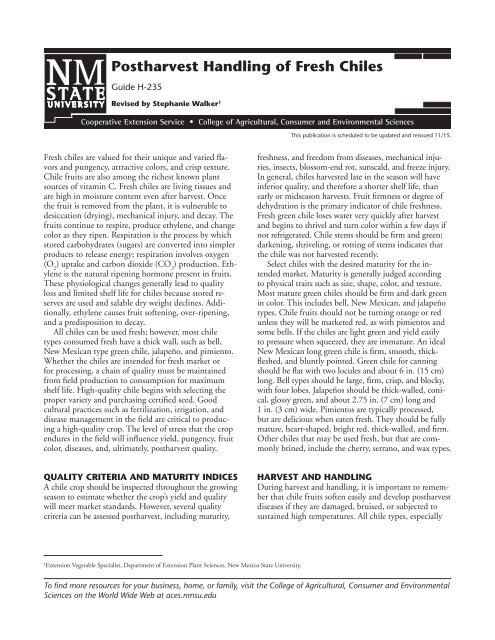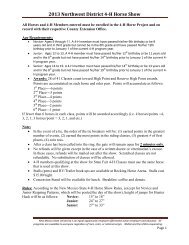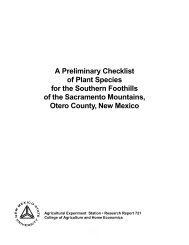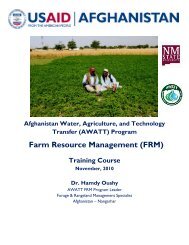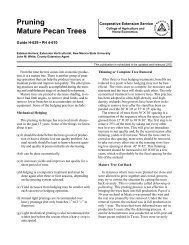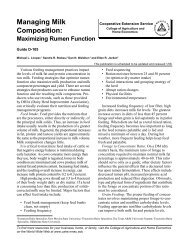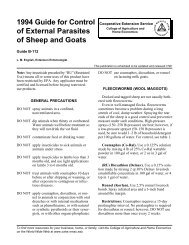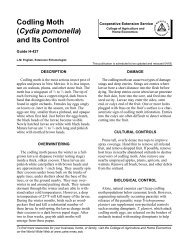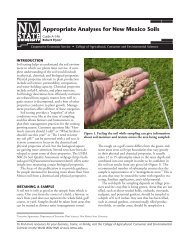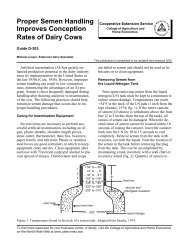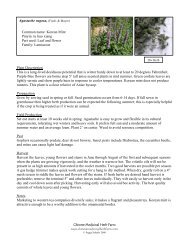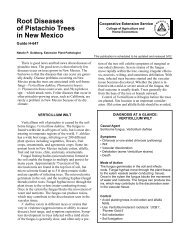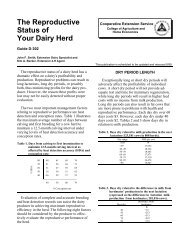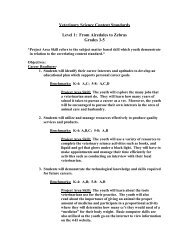Postharvest Handling of Fresh Chiles - NMSU's College of ...
Postharvest Handling of Fresh Chiles - NMSU's College of ...
Postharvest Handling of Fresh Chiles - NMSU's College of ...
You also want an ePaper? Increase the reach of your titles
YUMPU automatically turns print PDFs into web optimized ePapers that Google loves.
<strong>Postharvest</strong> <strong>Handling</strong> <strong>of</strong> <strong>Fresh</strong> <strong>Chiles</strong>Guide H-235Revised by Stephanie Walker 1Cooperative Extension Service • <strong>College</strong> <strong>of</strong> Agricultural, Consumer and Environmental SciencesThis publication is scheduled to be updated and reissued 11/15.<strong>Fresh</strong> chiles are valued for their unique and varied flavorsand pungency, attractive colors, and crisp texture.Chile fruits are also among the richest known plantsources <strong>of</strong> vitamin C. <strong>Fresh</strong> chiles are living tissues andare high in moisture content even after harvest. Oncethe fruit is removed from the plant, it is vulnerable todesiccation (drying), mechanical injury, and decay. Thefruits continue to respire, produce ethylene, and changecolor as they ripen. Respiration is the process by whichstored carbohydrates (sugars) are converted into simplerproducts to release energy; respiration involves oxygen(O 2) uptake and carbon dioxide (CO 2) production. Ethyleneis the natural ripening hormone present in fruits.These physiological changes generally lead to qualityloss and limited shelf life for chiles because stored reservesare used and salable dry weight declines. Additionally,ethylene causes fruit s<strong>of</strong>tening, over-ripening,and a predisposition to decay.All chiles can be used fresh; however, most chiletypes consumed fresh have a thick wall, such as bell,New Mexican type green chile, jalapeño, and pimiento.Whether the chiles are intended for fresh market orfor processing, a chain <strong>of</strong> quality must be maintainedfrom field production to consumption for maximumshelf life. High-quality chile begins with selecting theproper variety and purchasing certified seed. Goodcultural practices such as fertilization, irrigation, anddisease management in the field are critical to producinga high-quality crop. The level <strong>of</strong> stress that the cropendures in the field will influence yield, pungency, fruitcolor, diseases, and, ultimately, postharvest quality.freshness, and freedom from diseases, mechanical injuries,insects, blossom-end rot, sunscald, and freeze injury.In general, chiles harvested late in the season will haveinferior quality, and therefore a shorter shelf life, thanearly or midseason harvests. Fruit firmness or degree <strong>of</strong>dehydration is the primary indicator <strong>of</strong> chile freshness.<strong>Fresh</strong> green chile loses water very quickly after harvestand begins to shrivel and turn color within a few days ifnot refrigerated. Chile stems should be firm and green;darkening, shriveling, or rotting <strong>of</strong> stems indicates thatthe chile was not harvested recently.Select chiles with the desired maturity for the intendedmarket. Maturity is generally judged accordingto physical traits such as size, shape, color, and texture.Most mature green chiles should be firm and dark greenin color. This includes bell, New Mexican, and jalapeñotypes. Chile fruits should not be turning orange or redunless they will be marketed red, as with pimientos andsome bells. If the chiles are light green and yield easilyto pressure when squeezed, they are immature. An idealNew Mexican long green chile is firm, smooth, thickfleshed,and bluntly pointed. Green chile for canningshould be flat with two locules and about 6 in. (15 cm)long. Bell types should be large, firm, crisp, and blocky,with four lobes. Jalapeños should be thick-walled, conical,glossy green, and about 2.75 in. (7 cm) long and1 in. (3 cm) wide. Pimientos are typically processed,but are delicious when eaten fresh. They should be fullymature, heart-shaped, bright red, thick-walled, and firm.Other chiles that may be used fresh, but that are commonlybrined, include the cherry, serrano, and wax types.QUALITY CRITERIA AND MATURITY INDICESA chile crop should be inspected throughout the growingseason to estimate whether the crop’s yield and qualitywill meet market standards. However, several qualitycriteria can be assessed postharvest, including maturity,HARVEST AND HANDLINGDuring harvest and handling, it is important to rememberthat chile fruits s<strong>of</strong>ten easily and develop postharvestdiseases if they are damaged, bruised, or subjected tosustained high temperatures. All chile types, especially1Extension Vegetable Specialist, Department <strong>of</strong> Extension Plant Sciences, New Mexico State University.To find more resources for your business, home, or family, visit the <strong>College</strong> <strong>of</strong> Agricultural, Consumer and EnvironmentalSciences on the World Wide Web at aces.nmsu.edu
New Mexican green chiles, are highly susceptible towater loss, sunscald, and heat damage. These problemsare likely to occur if chiles are allowed to sit for morethan an hour in direct sunlight. <strong>Fresh</strong> chile harvestedin the summertime can have pulp temperatures <strong>of</strong> 90°F(32°C) or more. For these reasons, chiles should be harvestedin the early morning, placed in the shade, andcooled as soon as possible. If the chiles are not cooledwithin 1 to 2 hours, they will begin to show signs <strong>of</strong>water loss and s<strong>of</strong>tening.Most fresh chile is harvested by hand into bucketsor sacks and then emptied into bulk bins for transportto the packing shed or processor. A field <strong>of</strong> long greenchiles can be harvested in early August and then againin September. A third harvest will typically yield smallfruits and may not be pr<strong>of</strong>itable.Once at the shed, the chile is either dry-dumpedonto padded ramps or moving conveyor belts, or wetdumpedinto a chlorinated wash tank. Wash tanksshould be cleaned daily, and the chlorination levelsshould be monitored frequently. These sanitation practicesare necessary because chiles are highly susceptibleto bacterial diseases that could be introduced throughthe wash tanks. Fruits are then sorted to remove diseased,overripe, immature, or otherwise defective pods.Grading according to USDA or other market standardscan be done after sorting.<strong>Fresh</strong> chile is typically packed in 1 1/4 bushel sizecorrugated cartons that hold 30 lb. Another packagetype is the 2-piece telescope style, with a lid that fitsover the body. The boxes may be waxed, and shouldhave top and bottom gaps and side slots for ventilationand cooling. Cartons should be sufficientlystrong to endure stacking and shipping. Boxes shouldbe stacked in a 3 × 2 cross-stack pattern, 6 high on a40 × 48-in. pallet.Packages with plastic (polyethylene) liners or bagshave an additional barrier to fruit moisture loss. Plasticfilms reduce water loss from the chiles, but may interferewith cooling efficiency. Small perforations in theplastic will compensate for the barrier by improvinggas exchange and increasing the airflow during coolingand storage. <strong>Chiles</strong> can also be packaged in smallconsumer units for retail markets using plastic bags ortrays wrapped with films. These retail packages can beprepared at the packing shed or, more commonly, at thedistribution center.Both storage temperature and package container influencechile fruit weight loss (Figure 1). <strong>Chiles</strong> storedin boxes have a daily weight loss <strong>of</strong> about 3.5% at 75°F(24°C), but only 0.5% at 46°F (8°C). The use <strong>of</strong> plasticwrappedtrays or polyethylene bags decreases fruit weightloss further, especially at lower storage temperatures.Figure 1. Percent weight loss <strong>of</strong> New Mexican long greenchile stored at either 75°F (24°C) or 46°F (8°C) andpackaged in boxes, wrapped trays, or polyethylene bags.During the first week <strong>of</strong> storage, boxed fruit had a dailyweight loss <strong>of</strong> 3.5% at 75°F and 0.5% at 46°F.COOLING AND STORAGE<strong>Fresh</strong> chile is a highly perishable commodity. Propercooling extends the shelf life by slowing respiration, waterloss, color change, and decay. Temperatures higherthan 70°F (21°C) greatly accelerate ripening throughrespiration and ethylene production. Preferred coolingmethods for chiles are room cooling and forced-air cooling.Cooling and storage are independent operations andthe specific requirements for rapid cooling should thereforebe considered separately from cold storage needs.Room cooling exposes fresh produce to cold air in arefrigerated space. Bins or boxes must be stacked properlyto permit airflow between the individual storage units.Room coolers can be partitioned into sections so thatrecently harvested chiles with high field heat are keptseparate from previously cooled produce. Powerful fansand ceiling jets can be used to increase the airflow and,consequently, the cooling efficiency <strong>of</strong> room coolers.Forced-air cooling is an active cooling process and ismuch faster at removing field heat than room cooling.With forced-air cooling, fans pull cool air through theboxes or bins <strong>of</strong> produce. Room coolers can be modifiedinto forced-air coolers relatively quickly and inexpensivelyby adding extra fans and partitions.Guide H-235 • Page 2
Figure 2. Diagram <strong>of</strong> a forced-air cooling tunnel design.There are several variations <strong>of</strong> forced-air cooling designs;the most common is the forced-air tunnel design(Figure 2). In this system, a row <strong>of</strong> bins or palletizedboxes is placed on either side <strong>of</strong> an exhaust fan, creatingan aisle between the two rows. The aisle and open endare covered with canvas to form a tunnel. The exhaustfan creates negative pressure in the tunnel and pulls coldair through the stacks to cool the produce. Containersmust be adequately vented for proper airflow duringforced-air cooling.Forced-air evaporative cooling is a system that usesevaporative coolers instead <strong>of</strong> refrigeration units. Thiscooling system is practical in New Mexico because <strong>of</strong>our arid climate. An evaporative cooler is more energyefficientthan mechanical refrigeration, and growers canbuild their own systems. Forced-air evaporative coolerscan lower the product temperature to about 60°F(16°C) and are most useful for chilling sensitive commodities(such as chiles) intended for a local market.The optimum storage conditions for fresh chilesare 45 to 50°F (7-10°C) and 90 to 95% relative humidity.Chilling injury occurs at lower temperatures.The symptoms <strong>of</strong> chilling injury are s<strong>of</strong>tening, pitting,and an increased susceptibility to decay. Freeze damageoccurs at 32°F (0°C). Most fresh chiles can be storedfor 2 to 3 weeks if kept cool at the proper temperature.<strong>Chiles</strong> should be shipped on refrigerated trucks, butthese vehicles should not be used for pre-cooling becauserefrigerated trailers do not have adequate coolingcapacity or ventilation to remove field heat quickly.Transit cooling is intended only to keep previouslycooled produce cold during shipping.Poor temperature management and ethylene accumulationduring storage or transit promote ripeningand decay. Some fruits and vegetables produce muchlarger quantities <strong>of</strong> ethylene than chiles. For that reason,chiles should never be stored or shipped with crops suchas tomatoes, apples, or melons. Storage rooms shouldbe ventilated properly to reduce the accumulation <strong>of</strong>ethylene in the environment. Placing ethylene scrubberscontaining potassium permanganate in the storage roomor transit vehicle can also decrease ethylene levels.Maintaining a chain <strong>of</strong> quality from grower throughconsumer is essential when handling fresh chiles. Thebasis <strong>of</strong> the chain <strong>of</strong> quality is proper cooling, butminimizing mechanical injuries, diseases, and ethyleneexposure are also critical for maximum chile quality.Original author: Marisa M. Wall, former assistantpr<strong>of</strong>essor <strong>of</strong> horticulture.Guide H-235 • Page 3
Contents <strong>of</strong> publications may be freely reproduced for educational purposes. All other rights reserved. For permission to usepublications for other purposes, contact pubs@nmsu.edu or the authors listed on the publication.New Mexico State University is an equal opportunity/affirmative action employer and educator. NMSU and the U.S. Department<strong>of</strong> Agriculture cooperating.Revised November 2010Las Cruces, NMGuide H-235 • Page 4


